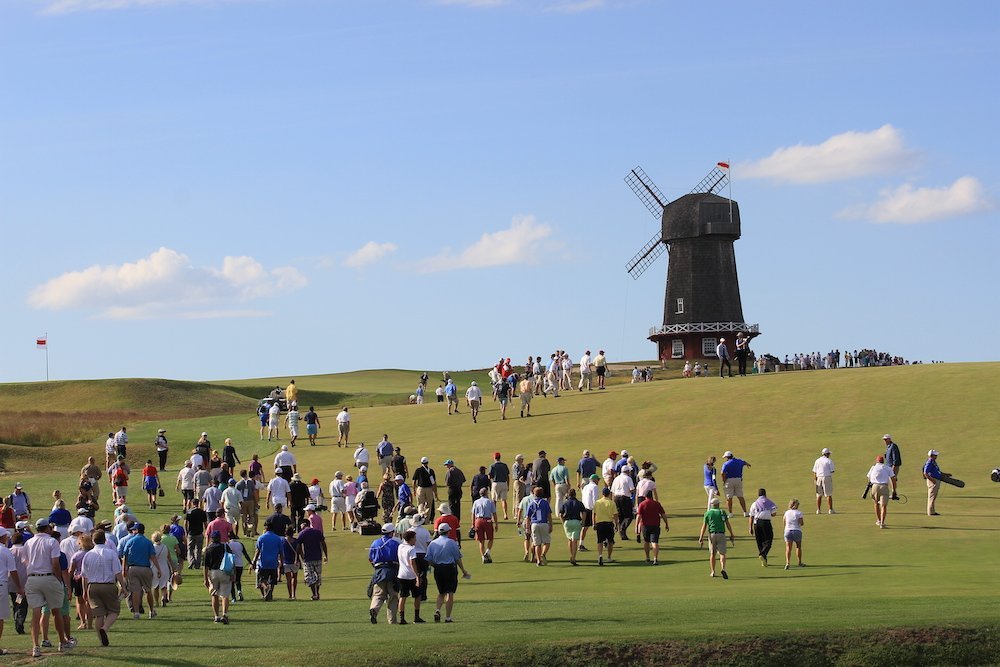Number 6: National Golf Links of America
Ceiling: 96.5
Rating: 94
Trend over Time: 8.5
Photo Credit: Golf Digest
The OG template course, Charles Blair Macdonald’s masterpiece, and a true relic of architecture, National Golf Links is one amazing place to play golf. One of the things I am so taken aback by about National is how truly linksy it feels. The grass, ground conditions, course presentation, and obviously design all are enough to nearly trick you into to thinking you are across the pond. The club culture, although not identical to a British or Scottish one, has the depth to match many of the UK’s finest as well. From the jacketed lunch and amazing clubhouse to the setting on the Peconic Bay, National has more cultural depth than most any club I’ve been to in the states. You immediately feel immersed in the club’s age old traditions when you are there. And that, to me, is the height of what makes a great golf course/club a truly world class one. Playing National is not just playing a great course, it’s a full-on experience. And a damn good one.
Mike Gibbons: Gunga Galunga
Culture:
NGLA is Long Island, or maybe Long Island is NGLA. One of the two. The Southsides, Lobster at lunch, gingersnaps, PB, ritz crackers and whiz, its New York centric membership, the curt locker room attendant, there is no mistaking where National is situated. The club is old school and has an “old boys club” feel to it, but the culture around the golf is also fantastic. The passion for architecture and what they have in their golf course is tangible. National is one of those places that has a “take it or leave it” feel to the day. It has been the way it is for a while, and it will remain that way. If you don’t like something about it, that’s just fine. Especially with regard to the course, each day at National usually presents something that will throw you off and provide a bit of friction to the experience, but like a great book or movie, by the end of the experience, all you want is to go right back to the start and do it again.
Competition:
NGLA hosted the first Walker Cup matches in 1922 and subsequently saw the competition return in 2013. Further, National has the 2030 Curtis Cup matches on the docket and hosts “The Singles,” a mid am match play event each summer. Match play is an ideal format for National with it being only 6900 yards give or take from the back tees. There are plenty of holes that you would not want to see lengthened purely to drive scores higher, but a stroke play competition might see that happen to manage scoring. Much like The Old Course, NGLA is the rare site in today’s golf landscape where reverence for the course’s history supersedes modern expectations of scoring or distance. The course is meant to flex its muscles through its quirk rather than brute force and keeping it designated for match play allows it to do so. I must imagine it is a frustrating place to compete in certain ways as the course is not one that is right in front of you or overly intuitive. Again, this is why match play is an ideal format for National.
Photo Credit: Geoff Shackelford (Tie guest: listen here)
Architecture:
National is almost like a museum of architecture. Playing there you will see so many bunker shapes and types you could never have imagined. Obviously, the course has a number of template holes, and the real kicker to me is the variety the property provides. The drama to the landscape is far greater than I feel many associate with it. There are several holes where large ridges and slopes create all the intrigue you could want in a golf hole, and then when you couple that with some of the more interesting greens and bunkers you will ever see, you have quite the recipe for amazing golf. The other piece of National that is so unique is the closing stretch’s interaction with the tidal areas of the Peconic Bay. Not many golf holes vary based on tides, but a few at National do just that and the character this gives the back nine is truly unmatched. National is one of those courses that I truly feel lucky to have been able to play as it is an essential element of American golf course architecture history.
Mike Gibbons: Gunga Galunga




